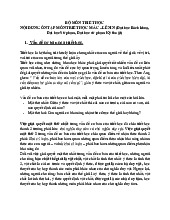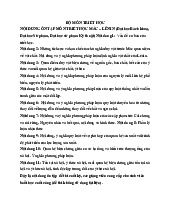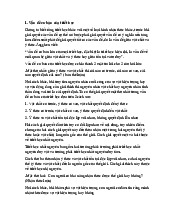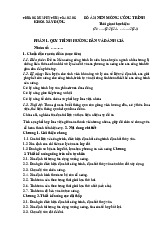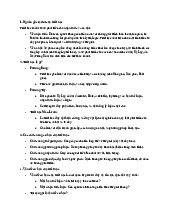





Preview text:
KỲ THI TỐT NGHIỆP TRUNG HỌC PHỔ THÔNG NĂM 2022 ĐỀ THI THAM KHẢO
Bài thi: NGOẠI NGỮ, Môn thi: TIẾNG ANH
Thời gian làm bài: 60 phút, không kể thời gian phát đề
Họ, tên thí sinh:…………………………………..
Số báo danh:……………………………….…….. ĐỀ SỐ 01
Mark the letter A, B, C, or D on your answer sheet to indicate the correct answer to each of the following questions.
Question 1: That sort of extreme diet is not ______ over a long period. A. sustainably B. sustainability C. sustainable D. sustain
Question 2: The boys were at home yesterday, _______? A. didn’t they B. weren’t they C. were they D. do they
Question 3: The concert only lasted an hour, so we felt we were getting _______ measure. A. small B. low C. short D. long
short measure: thấy còn thiếu
Question 4: The Internet was invented _______ the 20 century. A. at B. in C. with D. from
Question 5: My cousin wanted to change his career because he wasn’t very satisfied with his _______. A. winnings B. earnings C. proceeds D. savings
A. winnings: tiền từ việc cờ bạc, thi thố
B. earnings: tiền kiếm được bằng công việc (change his career)
C. proceeds: tiền thu được do bán hang, trình diễn D. savings: tiền để dành
Question 6: That school was closed last month _______ ten teachers tested positive for Covid-19. A. because of B. because C. though D. in spite of
Question 7: When I was walking to school this morning, I saw a _______ girl. She asked me how to get to the station.
A. beautiful young Korean
B. beautiful Korean young
C. young beautiful Korean
D. Korean young beautiful
Question 8: Everybody in the house woke up when the burglar alarm _______. A. went up B. went off C. came across D. came off
Question 9: While my father _______ a film on TV, my mother was cooking dinner. A. watched B. was watching C. had watched D. watches
Question 10: When I find out the truth, I will let you know.
A. When I had found out the truth
B. When I find out the truth
C. When I was finding out the truth
D. When I found out the truth
Question 11: My sister _______the washing up every day. A. makes B. does C. takes D. gives
Question 12: It is widely thought that stress can _______ your immune system. A. reduce B. degrade C. decline D. weaken
weaken your immune system: làm yếu hệ miễn dịch
Question 13: The students _______to be at school by the teacher at 8:00 am yesterday. A. tell B. told C. have told D. were told
Question 14: _______ from university, he started his journey to find a suitable job.
A. Have graduated B. Having graduated
C. Have been graduated D. Have been graduating
Question 15: _______people dance, the more confident they feel. A. The more B. Most C. Most of D. More
Mark the letter A, B, C, or D on your answer sheet to indicate the sentence that best completes
each of the following exchanges.
Question 16: Michael and Linda are at the schoolyard.
- Michael: “Do you prefer relaxing holidays, or would you rather go on an adventure?” - Linda: “_______”
A. To be honest, that sounds great.
B. Honestly, I’m not the adventurous type.
C. As a matter of fact, I’d rather like them.
D. Why don’t you go for a holiday?
Question 17: Ann is new in Hanoi and she is on the road now.
- Ann: “Excuse me, is there a supermarket near here?” - Pedestrian: “_______”
A. It’s alright. B. It’s over there.
C. It’s not nice. D. Yes, you’ll go.
Mark the letter A, B, C, or D on your answer sheet to indicate the word that differs from the
other three in the position of stress in each of the following questions.
Question 18: A. quality B. industry C. computer D. confidence
Question 19: A. argue B. listen C. promise D. begin
Mark the letter A, B, C, or D on your answer sheet to indicate the word whose underlined part
differs from the other three in pronunciation in each of the following questions.
Question 20: A. cleans B. stops C. robs D. buys
Question 21: A. cat B. hat C. base D. fat
Mark the letter A, B, C, or D on your answer sheet to indicate the word(s) CLOSEST in meaning
to the underlined word(s) in each of the following questions.
Question 22: The student service center will try their best to assist students in finding a suitable part- time job. A. help B. allow C. make D. employ
Question 23: The primary aim of this course is to improve your spoken English. A. narrow B. main C. solid D. minor
Mark the letter A, B, C, or D on your answer sheet to indicate the word(s) OPPOSITE in
meaning to the underlined word(s) in each of the following questions.
Question 24: Peter is trying to get to sleep, so if you wake him up, he will fly off the handle. (mất bình tĩnh)
A. continue sleeping B. want to fly C. become angry D. keep calm
Question 25: Skills can be enhanced by the appropriate use of technology in certain circumstances. A. unsuitable B. unimportant C. ill-prepared D. irregular
Mark the letter A, B, C, or D on your answer sheet to indicate the sentence that best combines
each pair of sentences in the following questions.
Question 26: Wearing face masks is compulsory at public places. It is a must-do for everyone.
A. By no means are people required to wear face masks at public places.
B. On no occasion did people wear face masks at public places.
C. Under no circumstances do people wear face masks at public places.
D. On no account should people stop wearing face masks at public places.
Question 27: Bill really wants to buy a pair of shoes. He doesn’t have enough money.
A. Provided that Bill has enough money, he can’t buy a pair of shoes.
B. Bill wishes he had enough money so that he could buy a pair of shoes.
C. If Bill had enough money, he couldn’t buy a pair of shoes.
D. If only Bill had had enough money, he could have bought a pair of shoes.
Mark the letter A, B, C, or D on your answer sheet to indicate the underlined part that needs
correction in each of the following questions.
Question 28: He is diagnosed with autism when he was just over two. was A B C D
Question 29: Vietnamese athletes are determined to defend her regional throne in athletics. their A B C D
Question 30: It will require a collectable effort from the government, providers, and the media to A B C D
our goals. collective
Mark the letter A, B, C, or D on your answer sheet to indicate the sentence that is closes tin
meaning to each of the following questions.
Question 31: It isn’t necessary for US to discuss this matter in great detail.
A. We should discuss this matter in great detail.
B. We might discuss this matter in great detail.
C. We needn’t discuss this matter in great detail.
D. We mustn’t discuss this matter in great detail.
Question 32: “I’ll tell you about this interview, Lan.” said Tam.
A. Tam said to Lan that he will tell her about that interview.
B. Tam told Lan that I would tell you about that interview.
C. Tam told Lan that he would tell her about that interview.
D. Tam told Lan that she will tell him about that interview.
Question 33: We last went out together two years ago.
A. We haven’t gone out together for two years.
B. We didn’t go out together two years ago.
C. We went out together for two years.
D. We have gone out together since two years ago.
Read the following passage and mark the letter A, B, c, or Đ on your answer sheet to indicate
the correct word or phrase that best fits each of the numbered blanks from 34 to 38. Testing Games
How lucky can you be? Twelve-year-old Eloise Noakes has got the best job in the world - (34)
_______ out new games. A leading company held a competition to find young testers and Eloise
was selected to test games (35) _______ are about to be launched onto the market. Each week she is
given a different game to play before recording her thoughts on a form designed by the company.
As the company director said, “What better way to find out about games than to put them in the
hands of the customers who will make most use of them?” Eloise is (36) _______ with her new job
but she also takes it very seriously. She is allowed to keep the games after testing them. (37)
_______, she has decided instead to give them away to children less fortunate than herself. “I’ve got (38) of
games and some children don’t have any,” she explained.
(Adapted from Cambridge English First for Schools 1, 2015)
Question 34: A. doing B. trying C. carrying D. finding
Question 35: A. whom B. whose C. which D. who
Question 36: A. amused B. proud C. thankful D. delighted
Question 37: A. However B. Although C. Otherwise D. Moreover
Question 38: A. many B. plenty C. several D. much
Read the following passage and mark the letter A, B, c, or D on your answer sheet to indicate
the correct answer to each of the questions from 39 to 43.
Every day on radio, on TV, and in the newspaper, we hear, see or read about many problems
in the world, for example, pollution problems.
Air pollution is the first kind. It mostly comes from fumes released from motorbikes, cars,
airplanes, trains and poisonous gases emitted from factories. Also, waste is dumped anywhere,
even in the city where many people are living. The second pollution problem is sea pollution.
Many people earn their living from fishing in the sea, and the fish they catch feed many people.
But the sea has become so polluted from oil spills and factory wastes that the fish are dying. This
is not only killing the fish, but is also affecting those people who eat fish.
Seldom do you find a place nowadays that is not polluted. This problem is growing more
difficult every day. We must find a good solution that makes the world a better place to live.
(Adapted from http https://brainly.in/'question)
Question 39: What is the passage mainly about?
A. Some kinds of pollution in the world
B. Air pollution from factory
C. Effects and solutions of pollution
D. Sea pollution and its effects
Question 40: Which of the following is NOT mentioned in paragraph 1 as something that people can get information from? A. television B. the newspaper C. the Internet D. radio
Question 41: According to paragraph 2, which of the following can be a consequence of pollution?
A. Pollution affects those who eat fish.
B. Many people are living in the city,
C. Many people live on the money from fishing.
D. The fish caught feed many people.
Question 42: The word poisonous in paragraph 2 is closest in meaning to ______. A. crude B. toxic C. numerous D. clean
Question 43: The word that in paragraph 3 refers to ______. A. a place B. people C. a solution D. a problem
Read the following passage and mark the letter A, B, c, or Đ on your answer sheet to indicate
the correct answer to each of the questions from 44 to 50.
I’ve always wanted to learn how to dance. When I was younger, I loved going to discos and I
used to spend hours practicing moves in front of the mirror! I think I was quite good, but as I got
older, I became less confident. Recently I decided I’d join a dance class. The problem with most
dance classes is that you need a partner, and none of my male friends ever wanted to come with
me. I was beginning to give up on the idea when I came across a magazine article about Indian
dancing. It sounded great and best of all I could do it on my own! So, I found a class on the
Internet and booked myself into a course.
I turned up for the first lesson feeling very nervous. I needn’t have worried though because
everyone was really friendly. We were all female. The youngest was about eighteen and the oldest
was forty something. Our teacher came in looking fantastic in her traditional dance clothes and we
soon all caught her energy and enthusiasm. She put on the music immediately, which was a
combination of western pop songs set to an Indian beat, and we started following her moves. Any
nervousness soon disappeared because the moves were so complicated. There was no time to
worry about whether you’re doing them right!
I’ve noticed a lot of changes in myself since I started dancing. I’m much fitter and I feel more
confident. I’ve also made some great friends at the class. If you’re interested in dancing, or you
just want to feel fitter, I’d recommend Indian dancing!
(Adapted from PET Practice Teds by Jenny Quintana)
Question 44: Which of the following could be the title of the passage?
A. Simple Steps of Indian Dancing
B. Why People Enjoy Indian Dancing
C. How I Began My Hobby: Indian Dancing
D. Indian Dancing Is Difficult
Question 45: According to paragraph 3, in the first dance class _______.
A. everybody was keen to dance
B. nobody spoke to each other
C. everybody admired the teacher
D. a lot of time was spent discussing the moves
Question 46: The word “booked” in paragraph 1 is closest in meaning to _______. A. wrote B. enrolled C. pursued D. moved
Question 47: The word “them” in paragraph 3 refers to _______. A. the moves B. the songs C. the partners D. the friends
Question 48: The word “complicated” in paragraph 3 is closest in meaning to _______. A. relaxing B. difficult C. interesting D. beautiful
Question 49: Which of the following is NOT true according to the passage?
A. She is fitter and enjoys dancing.
B. She hasn’t always been confident,
C. She is satisfied with the dancing course.
D. She is good at Indian dancing.
Question 50: Which of the following can be inferred from the passage?
A. The writer likes listening to pop music.
B. Learners must have some dancing experience before joining the class.
C. There is no need to bring a partner to the dancing class.
D. The teacher inspired the writer to start dancing. HẾT
